
14 minute read
Three is the magic number





While residing in the UK, Kim Leonard has completed a hat trick of hot rod builds worthy of these pages. The ’29 Ford Model A Sport coupe you’re faced with here is the third to appear in these pages – and that qualifies him for membership of a pretty elite club in our book.
The first of those features came in the September ’81 issue, with the opening paragraph concentrating on the traditional English village Kim lived in. Ironically, Clive Prew went on to infer that the closest the residents of said village would ever get to street rodding was the local Young Farmers club. Why ironically? Well, these days, for one weekend a year, that village becomes the hotbed of rodding in the UK. It’s called Old Warden…
Enough about geography. The real focus of the feature was a Ford V4-powered Morris 1000 van that went by the name of Snowblind. Kim then set his heart on a ’32 roadster but that became a non-starter when he came across an unstarted Model B sedan delivery project. Running a Rover V8, the Jago-bodied Deuce appeared in the November ‘86 issue.
Next on the cards was a steel coupe, a ’33 5-window to be precise. Tony Jarvis helped out by chopping the body and fabricating the rolling chassis. Kim trailered the coupe to Bruntingthorpe on one occasion and subsequently finished off the build. By then though he had relocated to Orange County, California, having taken the then unfinished project with him. project with him.


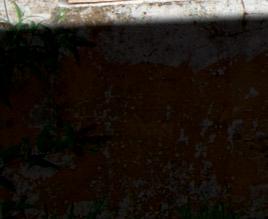
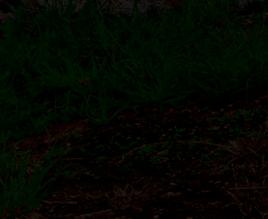






Sometimes, only when you really get to talk to people do you discover what a hot rod journey their life has been
Words: Dave Biggadyke Pics: Vic Peel



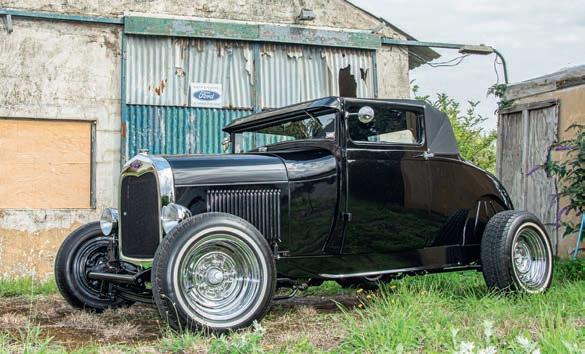

Above and below: The 4-inch dropped front axle is located by hairpins and hangs from a Russ Pepper supplied spring. Russ also supplied the front shocks, whilst the Ford F100 front brakes came from a guy in London. Steering is taken care of by a Vega box mated to a homemade column Below right: Front wheels are original 6 x 15 chrome reverse rims, whilst the rears are 7 x 15 chrome smoothies. Tyres are 165 Silvertown Radials and 215 Cooper Weather Masters respectively

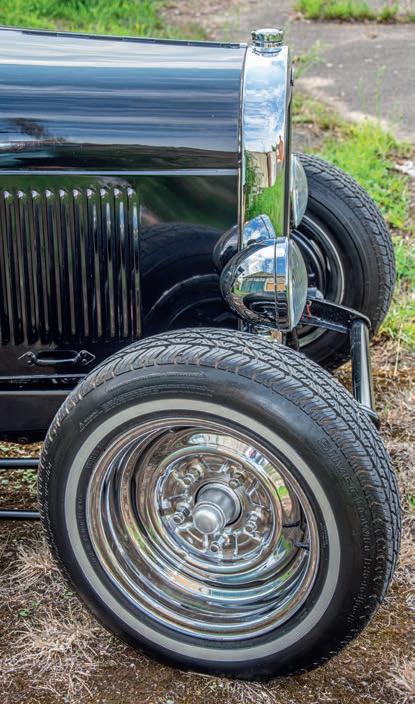
Divorce then bit and Kim was forced to sell the car. That was circa 1994 and, even back then, someone walked away with a bargain at $11,500.
Once Kim was back on his feet, a Pop was next to come up. He was still living in the States though, so he felt obliged to rebadge it as an Anglia. The sit-up-and-beg was small-block Chevy-powered and had first been rodded in the late ’70s / early ’80s. Sourced here in the UK, Kim had it shipped to California and had virtually finished the rebuild… when his life took another dramatic turn with him deciding to return to Blighty.
That was circa 2005. The Anglia was sold to help fund his passage home, bringing with him the pretty much unstarted Fordson project he also just happened to have on the go at the time.
By this time, Kim had remarried and, having settled into their new life in Lincolnshire, he and Morgan were heavily into renovating the former chapel they had bought to live in. Money was tight, as it always seems to be when you’re doing a building project, and Kim felt it only right to sell the van to help fund the build of the family home.
In a strange twist of fate, that very same van went on to be featured in these very same pages. That was in the April 2013 issue, by which time the Fordson had evolved into a machine far removed from Kim’s vision of how it would be built. All I need to do is drop in the name of the new


Above right: To keep running costs to an acceptable level, Kim opted for a 1600cc Ford Pinto mated to a Type 9 Ford 5-speed manual gearbox to provide the power for the coupe. ith the engine being low mileage, im left it well alone save for fitting a brand new eber carb, which he admits hit his wallet hard. A custom-built propshaft was made up by CF Parkinson in Boston, Lincs, whilst a Mk2 Jaguar radiator keeps things cool. Kim fabricated the exhaust system himself, utilising a NOS Austin 1100 silencer he came across at a local exhaust centre Above right: Russ Pepper of R&R Hot Rod Imports once again came up with the goods when Kim was in need of a grille shell Below left: The seats came via an ad on the Rods ‘n’ Sods forum and had been freshly retrimmed. Kim then hit on the idea of stripping an old leather sofa. That produced enough hide for Evans Upholstery and Trimming in Whittlesey, Peterborough to recover the seats, and a neighbour to trim the door cards. he headlining is brushed wool and the floor is covered courtesy of arpetright in palding, while the steering wheel is a genuine wood rimmed 1960s Superior 500 Below right: The 1960s Chris Craft speedboat chrome cluster houses a rev counter that pleases itself, a non-connected amps gauge and a fully functional Stewart Warner oil pressure gauge. Mounted directly in front of Kim are a Stewart Warner speedo and Green Line temperature gauge, along with a rare Sun fuel gauge. The 8-track player is a neat touch, albeit purely for show


owner and you will know the score, a certain Mr Phil ‘Ginner’ Middleton.
Body shop
Problem is, you can’t take the hot rodder out of the man and in 2012 Kim had made another purchase. The catalyst was eBay and the booty was the steel Model A Sport coupe pictured here. Only it wasn’t. What Kim bought was a body, and there wasn’t much of that as it happened. Geordie Paul had imported the body, essentially to fill a void in a container he was having shipped over. While many would have passed it by, Kim could see the potential – and besides, it came with some degree of pedigree.
‘The Sport coupe was first rodded in America in 1963 by Larry Goodson,’ explained Kim. ‘The car ran once at El Mirage in 1968, then the following year it was blown apart in readiness for a rebuild.
‘That never happened though, and after Larry died his widow asked his brother to sell the coupe as an unfinished project. There were no takers, however, so it was sold on as parts. After buying the body, I actually met up with Larry’s brother – who gave me the dash and Monarchs club plaque that was fitted to the car all those years ago.’
Kim and Morgan didn’t have a reserve of money to fund the build, so they set aside a strict monthly budget. Once that was spent, Kim patiently waited until the following month to purchase whatever part he needed next. While that protracted the
Sporting Life


The Sport coupe body as Kim bought it… …heavily chopped, but with no roof Not much of anything really, but what was there was pretty solid




Kim picked up the bonnet at the Swap Meet. Note half the roof is already now in place

he rolling chassis ready for fi nal welding and tidying up

he fi breglass style chassis rail covers. How common they are this month he glass roof was designed for a ’ roadster with Kim describing it as not even a close fi t for the Model


With the chassis painted, reassembly could begin fter being e tensively cut and shut the roof fi tted and im lined the inside of it in plywood in readiness for interior trimming
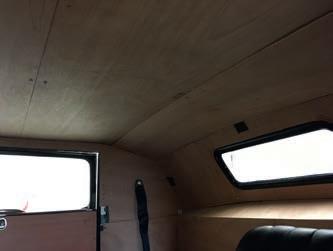

The job that Kim most detested, the wiring

Left: Rear lights are repro ’41-’48 Chevy, while the Monarchs club plaque is a survivor from the coupe’s original build Below: The Cortina rear axle is located by a triangular 4-bar arrangement, with a pair of GAZ coilovers completing the installation. The body was already chopped 6-inches and painted when Kim bought it. Some of the paint buffed up okay but he had to touch maybe 75% of it with rattle cans. He also covered the cut and shut ‘glass roof in waterproof canvas and formed the ali door gutters. The rear window came from Steve Henshaw’s Model A. Despite the obvious differences in running gear, Kim tells us that outwardly the Sport coupe looks pretty much as it did when it was fi rst rodded nigh on years ago
build process somewhat, it did keep a firm grip on expenditure.
In need of something to which to bolt the body, Kim bagged a stock Model A chassis via the NSRA forum. The front axle came from the same source, and when it came to the Mk4 Cortina rear axle Kim had his sights firmly set on one from an estate car. The choice of gearbox ratios and rear tyre size computed to 4.11 as being the ideal rear axle ratio and that’s exactly what was fitted to a Cortina estate.
A better look
Kim tack welded everything needed to form the rolling chassis but didn’t feel confident enough to complete the final welding to a satisfactory standard. A couple of fellow hot rodders chipped in to help him out though, Paul Murphy with the bracketry and Jon Gurney with the chassis boxing. With the car rolling, Kim pushed it out into the sunshine and his jaw instantly dropped. “The body looked crap mounted on top of the chassis,” he clarified. ‘It would have looked better channelled but as it was already chopped that wasn’t an option.’
His brain kicked in and he recalled in the distant past that dummy ’32 chassis-style fibreglass panels were available. Kim’s subsequent research turned up a kit car body manufacturer that had the moulds, and with that the somewhat mundane-looking Model A chassis was transformed.
That’s two feature cars in this issue that boast aesthetically improved chassis rails in this manner. Who would credit it?
Finishing touches included mounting the Morris 1000 fuel tank he had in stock inside the boot, having found it to be a perfect fit. Keeping it company is a rear passenger heater from a Rover P5, with the warm air it generates being ducted into the cab by hoses exiting under the seats. Kim did the wiring using a kit from Speedway, a task he vows he will never do again, and the coupe was first on the road two years ago.
There were no events to take it to back then though, and its first major outing was to the Supernats last year. That journey evoked yet more irony as the coupe broke
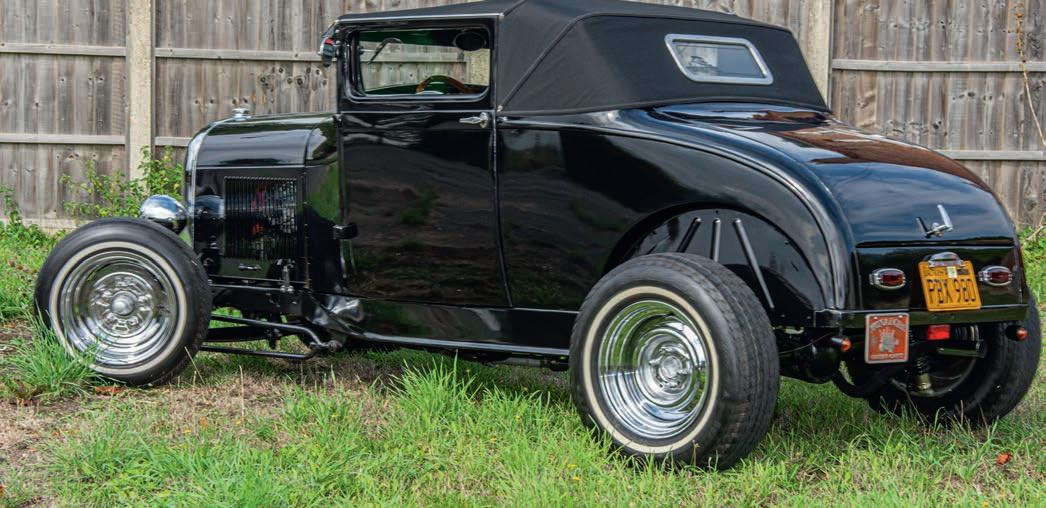









down and didn’t make it to the village where it all began for Kim.
With those teething issues now resolved, I asked Kim the inevitable question: how does it drive? ‘Pretty much as you expect a hot rod to drive,’ he quipped. ‘It will do seventy on the A1 but it doesn’t like potholes at all. Unfortunate that I now live in Lincolnshire, then.
‘It is 90-year-old technology after all, and that has to be taken into account. There are a couple of issues I want to address, the first being to reroute the exhaust tailpipe so it runs over the rear axle rather than under it. I also want to lower the seats as forward vision isn’t that great thanks to the severe chop. I’m developing a John Milner hunch and I don’t like that. I just want to make the car more pleasant to drive, I guess.’
Kim hinted that he may be interested in letting the coupe go to help fund another plan on the horizon, the ’32 coupe he’s already well on with building. That project is based around an all-steel 5-window body and original chassis he sourced from Maryland, with the rolling stock now upgraded to I-beam front and Ford 9-inch rear axles and a small block Chevy. Maybe that will become another notch on his belt when it comes to having vehicles featured in this here magazine.
Left: With the build based around a Jago body and chassis, Kim’s ’32 sedan delivery featured a Rover V8, BW trans’, Mk3 Cortina front suspension and a Jag IRS. Anyone think the backdrop for the Happy Home Bakery photoshoot looks familiar?
Above: Snowblind featured a 1700cc Ford V4, 2000GT gearbox and a chromed S type Jag IRS. Paint was a Vauxhall Polar White base enhanced with blue lip lop and Mirrafl ake, before being liberally coated in lac uer






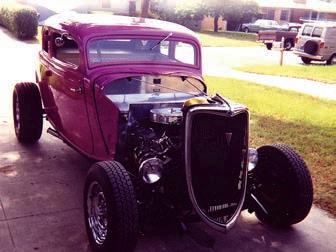


Someone bagged a real bargain when Kim had to sell his chopped ’33 coupe (above left). One that got away was the Fordson van (left) that went on to become an 8-second Outlaw Anglia race car with Ginner at the wheel. Kim’s latest project, a ’32 5-window coupe (above), is coming on nicely




Thanks












